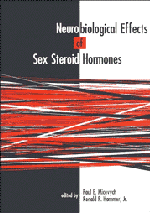Book contents
- Frontmatter
- Contents
- List of contributors
- Dedication
- Preface
- Acknowledgments
- Part I Sex steroid–responsive circuits regulating male and female reproductive behaviors
- 1 Hormonal influence on neurons of the mating behavior pathway in male hamsters
- 2 Neural circuitry for the hormonal control of male sexual behavior
- 3 Estrogen receptor mRNA: neuroanatomical distribution and regulation in three behaviorally relevant physiological models
- 4 Hormonal regulation of limbic and hypothalamic pathways
- Part II Sex steroid interactions with specific neurochemical circuits
- Part III Cellular and molecular mechanisms regulated by sex steroids
- Index
4 - Hormonal regulation of limbic and hypothalamic pathways
Published online by Cambridge University Press: 15 October 2009
- Frontmatter
- Contents
- List of contributors
- Dedication
- Preface
- Acknowledgments
- Part I Sex steroid–responsive circuits regulating male and female reproductive behaviors
- 1 Hormonal influence on neurons of the mating behavior pathway in male hamsters
- 2 Neural circuitry for the hormonal control of male sexual behavior
- 3 Estrogen receptor mRNA: neuroanatomical distribution and regulation in three behaviorally relevant physiological models
- 4 Hormonal regulation of limbic and hypothalamic pathways
- Part II Sex steroid interactions with specific neurochemical circuits
- Part III Cellular and molecular mechanisms regulated by sex steroids
- Index
Summary
The expression of sexually differentiated patterns of behavior is a characteristic of many vertebrate species and often correlates with sex differences in the relative abundance of neurons in brain regions thought to control such behaviors. In general, two fundamental processes determine the number of neurons that survive into adulthood. First, changes in the number of neuroblasts formed in the ventricular zone can occur in response to mechanisms that are intrinsic to a particular population of cells or that are controlled by extrinsic factors such as cell–cell interactions, neuronal growth factors, and circulating hormones. Second, similar extrinsic cellular and hormonal factors can determine the number of cells of a particular lineage that reach their permanent destination, establish appropriate connections, and achieve a regionally specific functional phenotype. Sex steroid hormones can affect both processes but appear to exert their most pronounced influences on neuronal development during a restricted perinatal critical period (Arnold and Gorski 1984; Breedlove 1986; Goy and McEwen 1980; Harris and Levine 1965; Rhees et al. 1990). Thus, treatment of female neonates with sex steroids during the first few postnatal days alters the number of neurons residing in certain nuclei, as well as the morphology, synaptology, and neurotransmitter expression of individual neurons (Arai et al. 1986; Arnold and Jordan 1988; De Vries 1990; Gorski 1985; Raisman and Field 1973; Simerly 1989, 1991).
- Type
- Chapter
- Information
- Neurobiological Effects of Sex Steroid Hormones , pp. 85 - 114Publisher: Cambridge University PressPrint publication year: 1995
- 16
- Cited by



